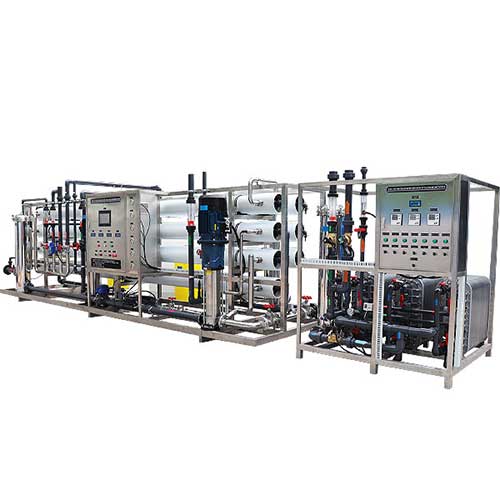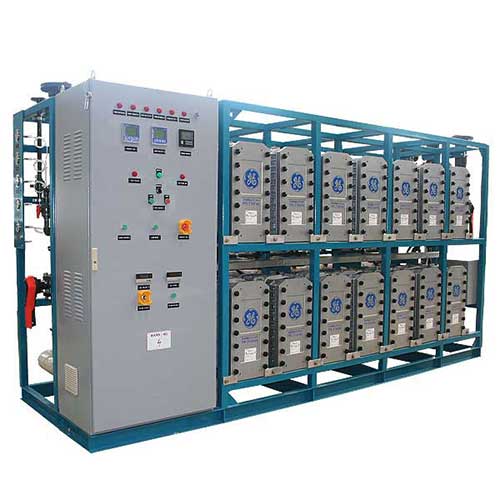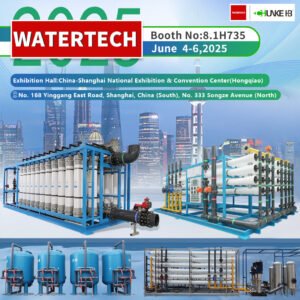
What is Continuous Deionization CDI?
Continuous deionization (CDI) is a water treatment process that is used to remove dissolved ions from water using ion-exchange technology. It is an electrochemical process that operates continuously, without the need for regeneration or replacement of ion-exchange resin beds, making it a cost-effective and low-maintenance method for water deionization.
In CDI, water flows between two electrodes, typically made of porous carbon material. When an electric potential is applied, ions in the water are attracted to the electrodes due to the electrical charge. The porous carbon material acts as a medium for ion adsorption and desorption.
As the water flows through the CDI cell, cations (positively charged ions) are attracted to the negatively charged electrode (cathode), while anions (negatively charged ions) are attracted to the positively charged electrode (anode). This creates a concentration gradient in the porous carbon material, where ions are removed from the water and held in the electrode.
The deionized water is collected from an outlet in the CDI system, while the concentrated ions are continuously flushed out through a separate outlet. The flushing process, called the regeneration step, involves reversing the electric potential to release the ions from the electrode, allowing them to be discarded.
CDI is particularly effective for removing ions such as calcium, magnesium, sodium, chloride, and sulfate. It is commonly used in various applications, including water purification, industrial processes, power plants, semiconductor manufacturing, and desalination. The benefits of CDI include low energy consumption, reduced chemical usage, and minimal waste generation compared to traditional ion-exchange processes.
What is Continuous Electrodeionization CEDI?

Continuous electrodeionization (CEDI) is a water purification technology that combines ion-exchange resin and electrochemical processes to remove dissolved ions from water continuously. It is also known as continuous deionization (CEDI) or continuous electro-deionization.
CEDI builds upon the principles of ion-exchange and electrodialysis. It consists of a series of ion-exchange membranes and ion-exchange resin compartments arranged alternately between an anode and a cathode. Water to be purified flows through the ion-exchange resin compartments.
When an electric current is applied across the electrodes, it creates an electric field that causes ions in the water to migrate towards the respective electrodes. Positively charged ions (cations) move towards the negatively charged cathode, while negatively charged ions (anions) move towards the positively charged anode. As the ions migrate through the ion-exchange resin compartments, they are captured and removed from the water by the resin.
The ion-exchange resin acts as a medium for the ion adsorption and desorption processes. Hence, it selectively adsorbs and releases the ions as they move through the compartments, allowing for continuous purification of the water stream.
The purified water exits the CEDI system, while the concentrated ions are continuously flushed out of the system. The flushing process is achieved by periodically reversing the electric current, which releases the ions from the resin and allows them to be discharged.
CEDI is commonly used in applications where high-purity water is required, such as in pharmaceutical manufacturing, power generation, electronics manufacturing, and laboratory settings. So, it offers several advantages over traditional ion-exchange methods, including continuous operation, reduced chemical usage, minimal waste production, and lower operating costs.
What is the Difference Between CDI and CEDI?
CDI (Continuous Deionization) and CEDI (Continuous Electrodeionization) are both water purification technologies that aim to remove dissolved ions from water. While they share similarities, there are a few key differences between the two processes:
1. Mechanism:
CDI operates primarily through ion adsorption onto porous carbon electrodes, whereas CEDI combines ion-exchange resin and electrodialysis principles. CDI relies on electrostatic attraction to remove ions, while CEDI combines ion exchange with the electrochemical migration of ions.
2. Electrodes:
In CDI, porous carbon electrodes are used to attract and adsorb ions from the water stream. In CEDI, the ion-exchange resin compartments act as the medium for ion adsorption and desorption. So, the electrodes in CEDI are typically made of inert materials such as titanium or stainless steel and do not directly participate in ion removal.
3. Regeneration:
CDI does not require regeneration since the adsorbed ions are flushed out during the regeneration step. In contrast, CEDI employs periodic electrical polarity reversal to release the captured ions from the ion-exchange resin. So, this regeneration step is necessary for maintaining the continuous operation of the system.
4. Application:
CDI is often used in applications where dissolved ion removal is desired but does not require the highest level of water purity. It is commonly used in industrial processes and water treatment applications. CEDI, on the other hand, is specifically designed for high-purity water applications, such as in pharmaceutical manufacturing, power generation, electronics manufacturing, and laboratory settings.
5. Efficiency:
CEDI typically achieves higher water purity levels compared to CDI due to the combination of ion exchange and electrodialysis. Hence, CEDI can remove a broader range of ions and contaminants, resulting in more effective deionization. However, CDI is generally considered more energy-efficient compared to CEDI.
In summary, CDI and CEDI differ in their operational mechanisms, electrode types, regeneration processes, applications, and water purity levels. CDI relies on ion adsorption onto porous carbon electrodes, while CEDI combines ion exchange with electrodialysis using ion-exchange resin compartments. CDI is commonly used in industrial processes, while CEDI is employed for high-purity water applications, accordingly.
Advantage of Continuous Deionization
Continuous Deionization (CDI) offers several advantages that make it a preferred water purification method in various applications:
1. Low Energy Consumption
CDI typically operates at lower energy requirements compared to other deionization processes, such as reverse osmosis or traditional ion exchange. It does not require high pressures or extensive pumping systems, resulting in energy savings.
2. Cost-Effective
CDI systems have lower operational costs compared to other deionization methods. Since CDI does not require regeneration or replacement of ion-exchange resin beds, the cost associated with chemicals and resin replacement is eliminated. It also reduces the need for frequent maintenance and downtime.
3. Continuous Operation
CDI operates continuously, providing a steady supply of deionized water without interruptions. There is no need for regeneration cycles or downtime for resin regeneration, enabling uninterrupted water production.
4. Scalability
CDI systems can be easily scaled up or down based on the required water treatment capacity. Multiple CDI cells can be configured in parallel to handle larger water flow rates, making it suitable for a wide range of applications.
5. Chemical-Free Operation
CDI does not require the use of chemicals for regeneration, unlike traditional ion-exchange processes. So, this reduces the environmental impact and the cost associated with chemical handling, storage, and disposal.
6. Reduced Waste Generation
CDI generates minimal waste compared to other deionization methods. So, the concentrated ions flushed out during the regeneration step can be treated or disposed of more efficiently due to the lower volume and concentration.
7. Flexibility
CDI can effectively remove a broad range of ions, including cations and anions, making it suitable for various water purification applications. It can target specific contaminants and adjust the ion selectivity by using different types of porous carbon electrodes.
8. Environmental Friendliness
CDI’s low energy consumption, reduced chemical usage, and minimal waste generation contribute to its environmentally friendly profile. It aligns with sustainability goals and promotes responsible water treatment practices.
Overall, the advantages of CDI, such as low energy consumption, cost-effectiveness, continuous operation, and environmental friendliness, make it an attractive option for water deionization in industrial, commercial, and residential settings.
Advantage of Continuous Electrodeionization CEDI
Continuous Electrodeionization (CEDI) offers several advantages that make it a preferred water purification method for high-purity applications:
1. High Water Purity
CEDI is capable of producing very high-purity water, often exceeding the levels achieved by other deionization methods. It can effectively remove a wide range of ions, including trace contaminants, resulting in water with exceptionally low conductivity and dissolved solids.
2. Continuous Operation
Similar to CDI, CEDI operates continuously, providing a steady supply of high-purity water without the need for regeneration cycles. This continuous operation ensures a consistent and reliable water purification process.
3. Chemical-Free Operation
CEDI does not require the use of chemicals for regeneration, unlike traditional ion-exchange methods. This eliminates the need for chemical handling, storage, and disposal, reducing operational complexity and potential environmental hazards.
4. Minimal Waste Generation
CEDI generates minimal waste during the purification process. It does not produce spent regeneration chemicals or require resin replacement, reducing waste disposal requirements and associated costs.
5. Reduced Maintenance
CEDI systems typically have lower maintenance requirements compared to other deionization technologies. They do not require frequent resin bed replacements or extensive cleaning processes, leading to reduced downtime and operational costs.
6. Precise Ion Removal
CEDI can selectively remove specific ions from the water, allowing for precise control over the water quality. It can target both cations and anions, ensuring effective removal of a wide range of contaminants and impurities.
7. Scalability
CEDI systems can be easily scaled up or down based on the required water treatment capacity. Multiple CEDI units can be configured in parallel or series to accommodate varying flow rates, making it adaptable to different applications and changing demands.
8. Application Versatility
CEDI is widely used in industries that require ultra-pure water, such as pharmaceutical manufacturing, power generation, electronics manufacturing, and laboratory settings. It ensures the high quality and reliability of water used in critical processes and applications.
While CEDI may have higher initial capital costs compared to some other deionization methods, its advantages in terms of water purity, continuous operation, chemical-free operation, and reduced maintenance make it a preferred choice in applications that demand the highest levels of water purity and quality.
how to decide to use CDI or CEDI
Deciding whether to use Continuous Electrodeionization (CEDI) or Continuous Deionization (CDI) depends on several factors. Here are some considerations to help you make an informed decision:
1. Water Purity Requirements
Assess the level of water purity required for your application. CEDI is typically chosen for high-purity applications where extremely low conductivity and dissolved solids are critical, such as in pharmaceutical manufacturing or electronics production. CDI may be suitable for applications that do not require the highest level of purity but still need effective deionization.
2. Contaminant Removal
Consider the specific ions or contaminants that need to be removed from the water. CEDI is capable of removing a wide range of ions, including trace contaminants, due to its ion-exchange and electrodialysis processes. CDI is effective at removing certain ions but may have limitations in removing trace contaminants or specific ions.
3. Water Flow Rate
Evaluate the required water flow rate for your application. CDI is generally more suitable for applications with higher flow rates due to its ability to handle larger water volumes. CEDI can also handle varying flow rates, but it may require multiple units in parallel or series to accommodate high flow rates effectively.
4. Energy Efficiency
Consider the energy consumption requirements and operational costs associated with each technology. CDI is often considered more energy-efficient than CEDI due to its simpler design and absence of membrane resistance. However, the energy efficiency of both technologies can vary depending on the specific system configuration.
5. Cost Considerations
Assess the capital costs and operational costs associated with each technology. CEDI systems typically have higher initial capital costs compared to CDI due to the complexity of the ion-exchange membranes. CDI systems may have lower operational costs since they do not require membrane replacement or periodic regeneration.
6. System Complexity and Maintenance
Evaluate the complexity and maintenance requirements of each technology. CDI systems are generally simpler and require less maintenance since they do not involve ion-exchange membranes. CEDI systems may require periodic membrane cleaning and replacement, adding to the maintenance needs.
7. Application Compatibility
Consider the specific industry or application requirements. CEDI is commonly used in industries such as pharmaceuticals, power generation, and electronics manufacturing, where high-purity water is essential. Meanwhile, CDI may be suitable for a broader range of applications, including industrial processes, water treatment, and commercial settings.
Ultimately, the decision between CEDI and CDI will depend on your specific water purification needs, required water purity levels, flow rates, energy efficiency considerations, cost considerations, and application requirements. Consulting with water treatment experts or suppliers can provide further guidance based on your specific circumstances.
Which Industries use Continuous Deionization and Electrodeionization?
CDI (Continuous Deionization) and CEDI (Continuous Electrodeionization) technologies are utilized in various industries where water purification and deionization are required. Here are some industries that commonly use CDI and CEDI:
Which Industries use Continuous Deionization?
1. Industrial Processes
CDI is employed in various industrial processes that require water deionization, such as chemical manufacturing, metal plating, pulp and paper production, and textile manufacturing. It is used to remove ions and impurities from water used in these processes to ensure product quality and prevent equipment fouling.
2. Power Generation
CDI is used in power plants, particularly in the boiler feedwater treatment process, to remove dissolved ions that could lead to scaling or corrosion in the boilers and other power generation equipment. It helps maintain the efficiency and reliability of power plant operations.
3. Semiconductor Manufacturing
CDI plays a crucial role in the semiconductor industry, where high-purity water is essential for cleaning, rinsing, and processing semiconductor wafers. It helps ensure the quality and reliability of semiconductor manufacturing processes.
Which Industries Use Continuous Electrodeionization?
1. Pharmaceutical Manufacturing
CEDI is extensively used in pharmaceutical manufacturing, where ultra-pure water is required for various purposes such as ingredient preparation, formulation, cleaning, and sterilization. It provides high-purity water that meets the stringent quality requirements of pharmaceutical production.
2. Electronics Manufacturing
The electronics industry relies on CEDI for the production of high-quality electronic components. CEDI ensures the purity of water used in circuit board cleaning, chip fabrication, and other electronic manufacturing processes that require exceptionally low levels of ionic impurities.
3. Laboratory Settings
Research laboratories and analytical facilities often utilize CEDI to produce ultra-pure water for experiments, analysis, and instrument calibration. CEDI helps maintain the integrity and accuracy of laboratory testing and research.
4. Power Generation (Nuclear)
CEDI is commonly employed in nuclear power plants for the production of ultra-pure water used in reactor cooling, steam generation, and other critical processes. The stringent purity requirements in nuclear power plants make CEDI an ideal choice for water treatment.
It’s worth noting that while these industries commonly use CDI or CEDI, the specific technology choice may vary depending on the unique requirements of each application and the desired water purity levels.
what is the cost of CDI and CEDI?
The cost of Continuous Deionization (CDI) and Continuous Electrodeionization (CEDI) systems can vary depending on several factors, including the system capacity, design complexity, required water purity, and specific project requirements. It is important to note that the following estimates are general and can vary significantly based on the specific circumstances:
cost of continuous deionization system
The capital cost of CDI systems is generally lower compared to CEDI systems. Depending on the size and capacity, CDI systems can range from a few thousand dollars for smaller, lower-capacity units to several hundred thousand dollars for larger systems used in industrial applications. The cost includes the CDI cell, control panels, pumps, filters, and associated components.
Operating costs for CDI systems are relatively low. CDI does not require regeneration chemicals or frequent resin replacement, reducing operational expenses. Energy consumption for CDI is typically lower compared to other deionization methods, resulting in lower utility costs.
cost of continuous electrodeionization system
CEDI systems tend to have higher capital costs compared to CDI systems due to the complexity of the technology. The cost of CEDI systems can range from tens of thousands of dollars for smaller laboratory-scale units to several hundred thousand dollars or more for larger, high-capacity systems used in industries like pharmaceutical manufacturing or power generation.
CEDI systems require ion-exchange membranes, electrode materials, and more advanced control systems compared to CDI. These components contribute to the higher capital costs of CEDI systems.
Operating costs for CEDI systems include periodic membrane cleaning and replacement, as well as energy consumption. While CEDI may have higher maintenance requirements compared to CDI due to the membranes, the operating costs can still be manageable given the high purity and continuous operation benefits.
It is important to note that these cost estimates are general and can vary significantly depending on the specific system design, capacity, customization, installation, and ongoing maintenance requirements. Consulting with water treatment equipment suppliers or system manufacturers can provide more accurate cost estimates tailored to your specific project.

